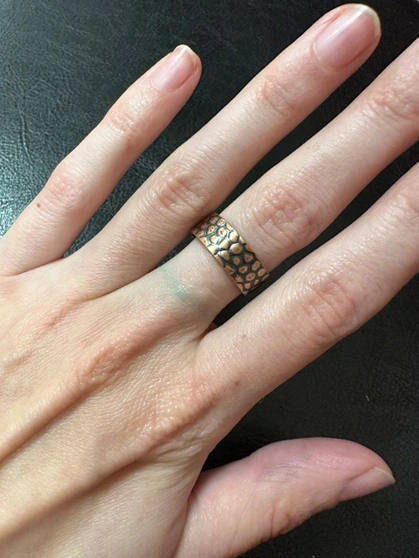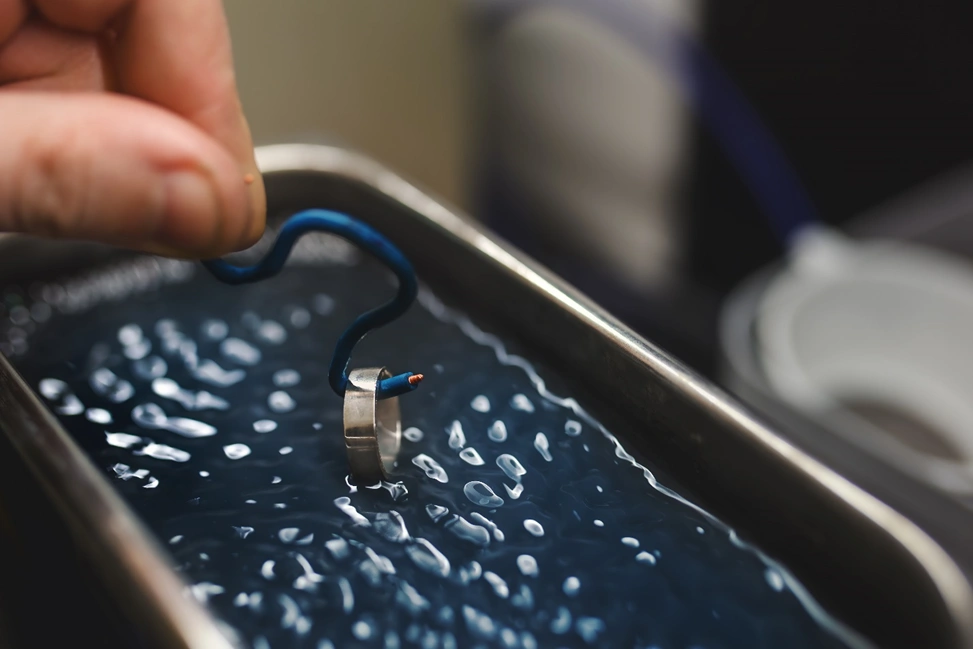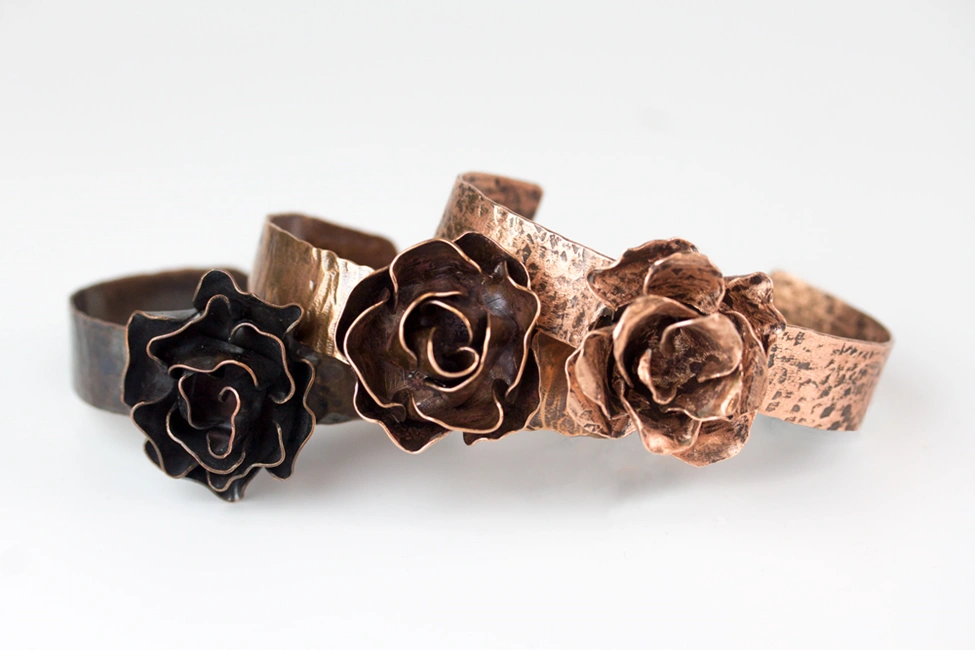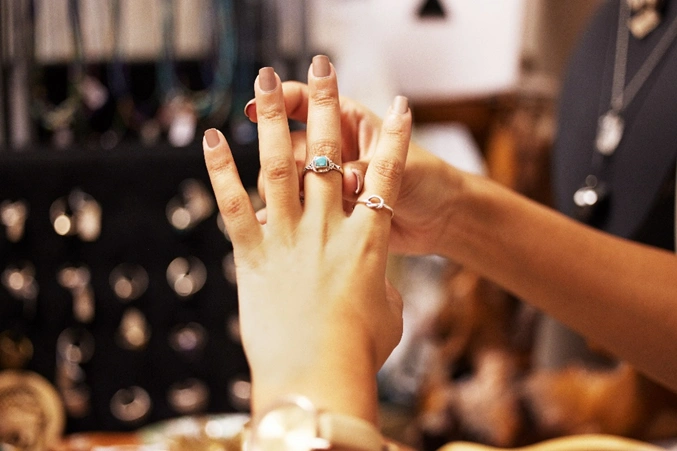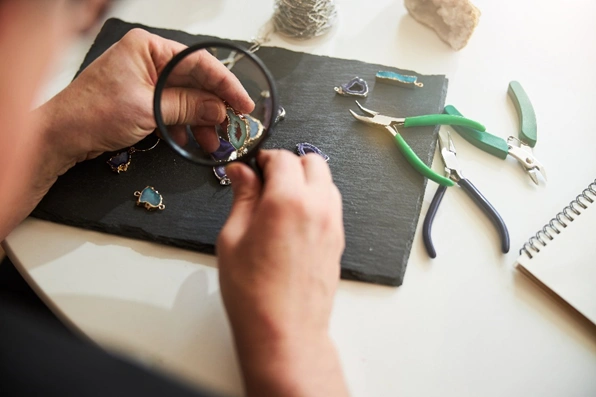Always wonder why jewelry sometimes turns your skin green? Or black? This article covers why that might happen and what it means. We’ll also talk about how to prevent it!
You may have experienced some jewelry turning your skin different colors after wear – green, black, or red. This usually happens with jewelry that’s tight to the skin, like rings or close fitting bracelets, but doesn’t mean it can’t happen with other forms of jewelry. You shouldn’t be alarmed though! Skin discoloration from jewelry is not usually dangerous or bad for your health. There are many reasons this happens including how an individual's personal skin pH reacts with metal. In this article we’ll dive into why jewelry can turn your skin different colors and what to do about it.
Green
Green is one of the most-seen skin discolorations from jewelry. It comes from copper in the jewelry reacting with salts, acids, and other chemicals. The reaction of copper with these things creates a patina of copper chlorides, sulfides, sulfates, and carbonates. Although they’ll color you’re skin, they’re not dangerous to you! The discoloration will go away on its own within a few days.
Why might some jewelry do this? Well, many metals that are used in jewelry are alloys, not pure metal. That means that there are a few different pure metals combined together. Sterling silver and any gold other than 24 karat gold are both alloys, and contain copper. Any metal that contains copper can turn your skin green. That means 14k gold, 18k gold, sterling silver, brass, bronze, or pewter can all do this. The higher the karat of gold, the less chance of turning your skin green. Because there’s more gold in higher karats, there are less of the other alloying metals, meaning less copper. Base metal jewelry made from pure copper sheet or copper wire will obviously have the highest likelihood of turning skin green.
Black
Black is another common skin discoloration color from jewelry. It typically comes from tarnish on sterling silver transferring to your skin. Tarnish can form when silver reacts with sulfur-containing gasses or liquids. Fine silver and sterling silver are both susceptible to tarnishing. Metal in any form, including silver sheet or silver wire, will have the same reaction. You may experience your silver jewelry tarnishing when it’s exposed to water with sulfur in it, hot tubs, and more. Keep in mind that silver alloys will tarnish over time regardless, not just when exposed to the liquids above. It requires polishing for maintenance.
The most common metals that will turn your skin black are sterling silver and gold alloys. Sterling silver is an alloy of fine silver and copper. Gold alloys contain a multitude of other metals as mentioned, and a common one is fine silver. The more sterling silver is worn, the less likely it is to tarnish, and therefore leave a mark on your skin. However, it can still happen to some people even when worn all the time.
Red
Red skin discoloration from jewelry is most often an allergic reaction or irritation. This can be because of a metal allergy, or things like lotion, sweat, or soap getting trapped under your jewelry. It can react with the metal causing skin irritation. Allergic reactions are specific to each individual. It’s best to avoid wearing metals that turn your skin red.
Nickel and chromium are the most common metals that will react with your skin in this way. Nickel often shows up in base metals that are often used under plated surfaces. Precious metals like gold, silver, and platinum are less likely to irritate your skin in this way because they are less reactive. However, white gold commonly has nickel in it and can cause reactions in some people. Although metals other than nickel and chromium are unlikely to cause skin irritation, it is still possible.
Jewelry Tip: To help prevent irritation, clean your jewelry regularly. Dish soap, warm water, and a soft toothbrush are perfect for all metals. Silver polishing cloths are ideal for silver and copper alloys.
How to Prevent Skin Discoloration
Preventing skin discoloration and irritation is pretty easy! For copper, it’s best to create a barrier between the metal and your skin. For rings, they can be coated on the inside to protect the wearer. Common products used are renaissance wax, beeswax, or coatings like clear nail polish or ProtectaClear. They can be a great solution for many people who frequently experience skin discoloration, but they do wear off over time. Coatings may need to be reapplied over time and with wear. Metal alloys, like sterling silver and gold alloys, like 14k gold, don’t typically need a barrier.
It’s also best to remove your jewelry before showering, washing your hands, applying lotions or perfumes, etc. The rule of thumb is – first thing off, last thing on! The ingredients in the above commonly react with metal to cause skin discoloration or irritation, so it’s best to avoid it when possible. Keeping your jewelry clean from lotion or dirt build up also helps reduce skin discoloration. Warm water, soap, and a soft toothbrush is great for all jewelry, especially if you have some dirt build up. A silver polishing cloth is perfect for more frequent cleanings, and works great on copper too!
What Jewelry Causes Discoloration
A common misconception is that only cheap/inexpensive jewelry or costume jewelry will cause skin discoloration. It is, however, more likely with this kind of jewelry. It often contains nickel or copper and is plated. That means it’s not solid gold or silver, and that layer of precious metal can wear away quickly, exposing the base metal underneath that’s likely to cause the discoloration.
Fine jewelry can still cause some people to react. As mentioned, gold and sterling silver are both alloys, containing some of the materials known to cause reactions – like copper and nickel. While white gold often contains nickel, it is usually rhodium plated and this minimizes any reactions people might have. Sterling silver is often rhodium plated as well to prevent tarnish. Rose gold plated and rose gold-filled items sometimes are flash plated with nickel before the layer of rose gold. Gold-filled items produced in Italy commonly use cobalt as part of the 14k gold alloy and can cause reactions in some people. Every producer of metal findings has their own special recipe and alloy they like to use, that’s why some 14k gold-filled jewelry may cause you a reaction and others may not.
Body Oils and Beauty Products
It’s important to remember that when looking at skin discoloration caused by jewelry, there are many factors influencing it. The material itself is of course important, but it’s reacting with the environment to cause the discoloration. That means lotions, water, salty air, perfume, sunscreen, chlorine, household chemicals, and more. Even one’s individual skin pH can cause reactions with metal. Our skin pH, sweat, and body oils change every day. Changes on the surface of your skin are related to variables like health, hormones, diet, and activities. You may notice a ring you’ve had for years suddenly turns your finger green or black one day. Because of the multitude of factors that impact your skin, it can be difficult to isolate a single cause for skin discoloration.
Beauty products like lotions, soaps, perfumes, hairspray, and more, are often contributing to discoloration reactions. It’s easy to forget that these products stay on the surface of your skin after application. The residues contain many ingredients that commonly react with metal jewelry. If you notice discolorations, try cleaning your skin to remove these products before putting on your jewelry.
While materials are a common culprit of skin discoloration, body pH, skincare products, and household chemicals are also to blame. You can never predict who will and who will not have a reaction to certain pieces of jewelry. Just be sure to educate your customer and pass along the tips above to help prevent any discoloration or irritation!
Looking for wholesale jewelry for your retail store? Check out Halstead Jewelry Supplies to see why thousands of retailers trust us for quality, bestselling jewelry.
Sources
Understanding How Silver Objects Tarnish
The Chemistry of Copper Patination
Continue Reading:





